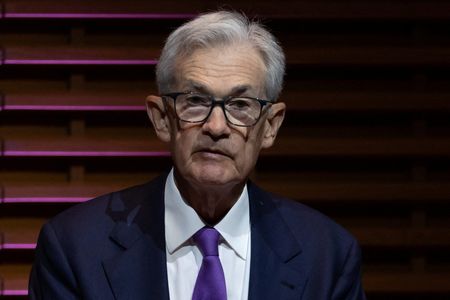By Jamie McGeever
ORLANDO, Florida (Reuters) -Central bankers choose their words carefully, so recent comments from the Federal Reserve’s two most senior policymakers that U.S. monetary policy could stay “restrictive” rather than “higher” for longer should not be overlooked.
While it may just seem like semantics, Fed Chair Jerome Powell and Vice Chair Philip Jefferson’s language increases the Fed’s flexibility on the near-term interest rate path and should ultimately cool nascent speculation that the next move could even be a hike.
Speaking at separate events in Washington on April 16, Powell and Jefferson both said policy could stay “restrictive” for longer if inflation doesn’t show clear signs of getting back down to the Fed’s 2% target.
Other Fed officials, most notably Atlanta Fed President Raphael Bostic, have spoken more bluntly on the possibility of raising rates, and traders have slashed the degree of expected policy easing this year to 40 basis points from 160 basis points in January.
The drum beat for no rate cuts at all this year is getting louder, so much so that talk of a possible rate hike is now swirling in financial markets.
But Powell calls the tune.
And it is significant that he and his number two stressed policy might stay “restrictive” for longer as opposed to the more oft-used ‘higher for longer’ phraseology.
The distinction is important, and barring a shock surge in inflation or un-mooring of inflation expectations, offers perhaps the most cogent case why the Fed will not raise rates.
In short, Fed policy can still be restrictive even if the policy rate is cut. Estimates suggest the fed funds target range could be lowered by 150-200 bps and still be in restrictive territory that, in theory, bears down on the economy, cools demand, loosens the labor market, and gets inflation down to 2%.
The Fed’s projected long-run 2.6% neutral rate minus its 2% inflation goal points to a real neutral rate – or ‘R*’ – of around 0.6%. Current policy is around 150-250 bps more “restrictive” than that, depending on the cut of inflation set against the current fed funds target range of 5.25%-5.50%.
Discussion around interest rates staying “higher for longer”, on the other hand, increases the emphasis on the nominal fed funds rate and turns the debate over the policy outlook into a more rigid, less nuanced, black-and-white call on the numerical level of interest rates.
That’s territory Powell and colleagues will want to avoid – saying policy may stay restrictive for longer rather than the nominal policy rate being higher for longer gives the Fed more wiggle room.
If the long run neutral policy that neither stimulates or curbs economic activity is 2.6%, as per the Fed’s March Summary of Economic Projections, and R* is around 0.6%, then 150-200 bps of policy restriction should be more than sufficient.
But if the long-run policy rate assumption rises further, that presumed level of ‘restriction’ at current rates may be less that assumed.
DUAL MANDATE
The Fed nodded to this in March when it nudged up its neutral rate forecast to 2.6% from 2.5%. It was a tiny but potentially significant move, and further increases in June and September could follow if inflation doesn’t budge.
The economy’s resilience right now – as seen in GDP growth rates, the labor market and consumer spending – may be casting doubt on the Fed’s longer term projections and assumptions, and in turn, how ‘restrictive’ its current policy stance actually is.
But increasing the policy rate?
“That would be very difficult. We would need to see a complete unhinging of inflation expectations,” said Joe Kalish, chief global macro strategist at Ned Davis Research.
Inflation expectations, as measured by surveys of consumers or the breakeven rates implied in inflation-protected bonds, are probably pointing higher on aggregate, but are by no means taking off.
The New York Fed’s latest survey of consumer expectations showed that the public’s one-year view held steady at 3%, the three-year outlook rose to 2.9%, while the five-year view dipped to 2.6%.
The University of Michigan’s latest survey showed one- and five-year expectations rising to 3.1% and 3.0%, respectively.
Five-year inflation breakeven rates, meanwhile, are up to 2.6%, the highest in a year, and the 10-year equivalent is up to 2.4%.
These numbers are all above the Fed’s hallowed 2%, but not so high as to force the Fed to pivot back towards raising rates. Breakeven inflation rates, for example, were above 3% in 2022 when the Fed started its tightening cycle.
Bank of America’s rates strategists agree that the bar for additional Fed hikes is high and that it would probably be signs of higher inflation expectations.
Citing “smoldering concerns” on commercial real estate, regional U.S. banks, and rising delinquencies, the Fed has plenty reasons not to raise rates, they say.
The Fed has managed to strike the delicate balance of bringing inflation down without generating a recession. It is on track, albeit slower than hoped, to achieve its dual mandate of achieving full employment and stable inflation.
“A restart of rate hikes would put this in jeopardy and potentially stoke financial stress across the corporate and household sector,” UBS analysts wrote on Thursday.
Powell almost certainly agrees.
(The opinions expressed here are those of the author, a columnist for Reuters.)
(By Jamie McGeever, Editing by Louise Heavens)





